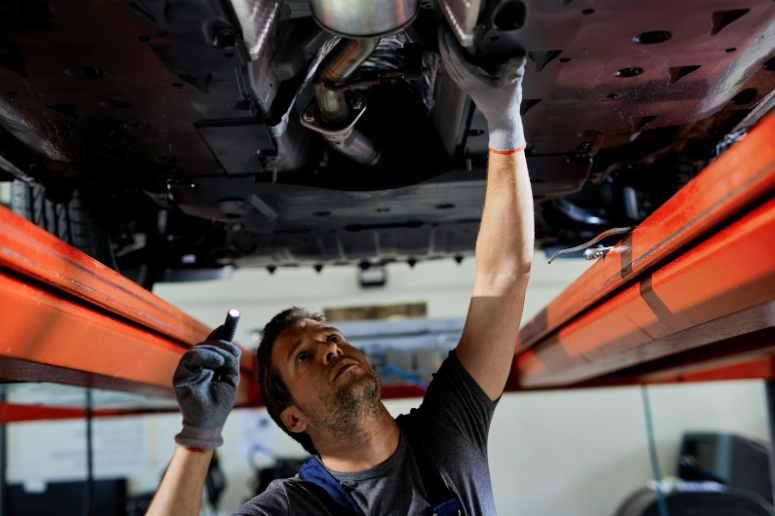Introduction
Power steering systems help make driving smoother and easier, especially when maneuvering at low speeds or turning into tight parking spots. But like anything mechanical, they can wear out over time. One issue Dodge owners might experience is a leak in the power steering system, and it's something that shouldn't be ignored. If left unresolved, it can lead to tougher steering, more wear on vehicle components, and even damage to other parts if the fluid runs low often enough.
For drivers in Grinnell, Iowa, handling issues like this quickly is part of keeping your ride ready for all seasons—hot July days or the frigid winter mornings. Spotting a leak early can save both time and stress later. Here’s how to recognize the signs, understand what causes the problem, and know how to go about tackling it.
Power steering systems help make driving smoother and easier, especially when maneuvering at low speeds or turning into tight parking spots. But like anything mechanical, they can wear out over time. One issue Dodge owners might experience is a leak in the power steering system, and it's something that shouldn't be ignored. If left unresolved, it can lead to tougher steering, more wear on vehicle components, and even damage to other parts if the fluid runs low often enough.
For drivers in Grinnell, Iowa, handling issues like this quickly is part of keeping your ride ready for all seasons—hot July days or the frigid winter mornings. Spotting a leak early can save both time and stress later. Here’s how to recognize the signs, understand what causes the problem, and know how to go about tackling it.
Spotting a power steering fluid leak early can often make the difference between a quick fix and a more serious repair job. Leaks commonly start off small but can turn into larger problems if ignored. They might lead to stiff steering or even damage other parts in the system due to added pressure on the pump and low fluid levels.
Here are a few ways to know if your Dodge has a power steering fluid leak:
- Steering feels heavy or stiff: This happens when the system doesn’t have enough fluid to assist you.
- Whining or groaning noises when turning: This sound usually means the fluid is low.
- Needing to top off fluid constantly: If you’re refilling more often than normal, the fluid’s going somewhere.
- A reddish or light brown puddle under your vehicle: Could be power steering fluid leaking out.
- Burning smell or smoke from the engine: Fluid may be leaking onto hot parts and burning while you drive.
To check for a leak, lift the hood and locate the power steering reservoir. Clean the area around it and then check the fluid level using the dipstick or markings. Refill if needed, then monitor it over the next few days. If it keeps dropping, begin inspecting hoses, connections, and the pump. Look for dried residue or wet spots that lead you to the source of the leak.
Causes of Power Steering Fluid Leaks in Dodge Vehicles
Once you've confirmed there's a leak, it's time to figure out what's behind it. Dodge vehicles have a few parts in the power steering system that can wear down or fail over time. Here are some of the main trouble spots:
1. Cracked or loose hoses
Power steering hoses transport fluid between the pump and steering gear. These can dry out and crack from long-term exposure to heat, engine grime, and extreme weather changes. This makes them a common source of leaks.
2. Damaged seals or O-rings
Seals prevent fluid from leaking out of the steering gear and other parts. Over time, these can shrink or harden, allowing fluid to escape. Keep an eye on the base of the steering gear and the pump for leaks around these spots.
3. A worn power steering pump
The pump itself can begin to fail with age and use. If it starts leaking from the housing or shaft area, you may be looking at pump replacement.
4. Loose or corroded fittings
Connections between hoses and other parts must stay tight. But over time, heat and corrosion can weaken these attachments and create tiny paths for fluid to leak out. If you hit gravel roads in summer or endure salty roads in winter around Grinnell, fittings can wear faster.
Once you’ve spotted the likely cause, it’s time to think about fixing the issue safely and thoroughly.
Steps to Fix Power Steering Fluid Leaks
If you're ready to fix the issue, it’s important to prepare properly. Driving around with a power steering leak might not stop you immediately, but it will eventually damage the system. The sooner you handle it, the better your chances of avoiding extra repairs.
Here’s a step-by-step approach:
1. Gather the right tools and supplies
You’ll likely need a wrench set, a drip pan, clean rags, and possibly replacement hoses, seals, or clamps. Make sure parts are right for your specific Dodge model.
2. Prep the vehicle for safety
Park on a level surface. Shut off the engine and let it cool down. Pop the hood and make sure you can reach the steering pump, lines, and fittings. Wear gloves and give yourself enough room to see and maneuver around the parts.
3. Track down the source of the leak
Once everything’s cool and clean, look closely at the power steering components. Gently wipe the suspected area and check for fresh leaking as fluid settles. Focus on hose ends, pump housing, and rack connections.
4. Replace or tighten faulty parts
If you find a cracked hose or a loose connection, replace the part or use a new clamp as needed. Make sure all fittings are snug. If the leak seems linked to the pump or inside the rack, it’s best to leave that to pros.
5. Test the repair
Refill the power steering reservoir with fresh fluid that meets Dodge specs. Start the engine and turn the wheel all the way left and all the way right several times. This purges air and circulates fluid. Check the level again and inspect for more leaks.
Fixes can usually be done fairly quickly if they don't involve hard-to-reach spots. If you’re unsure about removing components like the rack or pump, calling for help may save time and effort.
Preventive Measures and Professional Help
Power steering leaks can sneak up on you, especially if you’re not inspecting your fluids or listening closely while you drive. Preventing future problems takes just a few simple habits and a bit of attention.
To help keep your Dodge in shape:
- Check the fluid every couple of months. Make sure it’s clean and topped off.
- Look at the hose connections during oil changes or when rotating tires.
- Watch for new noises or tighter steering—it might mean something’s wrong.
- Don’t crank the steering wheel too far while stationary. That adds pressure on the system.
- In cold months, turn the wheel slowly at first. Give the system time to warm up.
Leaks that come from internal parts, pressure lines, or the pump often need special tools or training to fix. If something feels off and you're not comfortable doing the repair yourself, our certified technicians at WesFinch.com are ready to take a look.
Keeping Your Dodge Safe and Smooth on the Road
A small leak can lead to big problems if left alone. By spotting the early signs, inspecting the right components, and staying on top of fluid checks, you can avoid bigger repairs. A smooth ride with easy steering is more than just comfort—it means your Dodge is working like it should.
If you’re not sure where a leak is coming from or feel like the issue might be more than just a worn hose, it’s smart to hand it off to trained techs. Regular inspections and catch-it-early fixes help keep your car handling well through Iowa summers and winters. Stay alert on maintenance and steer clear of costly surprises later.
Keep your Dodge in peak condition and enjoy driving with confidence. If you're in the market for your next vehicle or just exploring options, take a look at our current cars for sale at WesFinch.com. From brand-new models to reliable options with a history, there's something here that fits your lifestyle.


